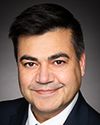Good evening, Mr. Chair and members of the committee.
thank you very much for the invitation to meet with you. I am very pleased to contribute to your important study on successes, challenges and opportunities for science in Canada.
Tuesday evening, you heard from Gilles Patry, of the U15 Group of Canadian Research Universities, and Mona Nemer, the chief science advisor, both of whom have close relationships with the University of Ottawa. I have no doubt that their presentations, as well as those of the other excellent witnesses, will be invaluable to the committee.
Before I begin, I would like to thank the government for the support you have given to post-secondary institutions across the country. I also want to express our appreciation for the vision of and the efforts by the chairperson that led to the creation of this standing committee that gives voice to science, research and innovation in Canada.
My name is Sylvain Charbonneau. I’m the vice-president of research and innovation at the University of Ottawa. Before joining the university, I worked as a researcher and executive director for the National Research Council of Canada. I also had my own small photonics business—right here, in Kanata North.
Over the past 30 years, I've had the unique privilege of being part of several transformative research evolutions and, more recently, to answer the call in my leadership role at the University of Ottawa on everything from the pandemic to advanced technology in areas such as quantum, 5G and cybersecurity.
With excellence, relevance and impact as our guideposts, uOttawa is spearheading research and innovation initiatives that align with industry-relevant research, the translation of research-derived innovations to products and start-ups, and the development of an entrepreneurial mindset at all levels of the university.
This means creating an ecosystem that bridges together academia, government and industry for the commercialization of discoveries into the next generation of high-growth companies, new investments and the creation of jobs. Whether it is building the first-ever university industry research lab in the heart of Canada's largest technology park in Kanata North, or a first-in-Canada partnership with IBM in cybersecurity or working with Telus to make our campus 5G ready, our institution is playing a critical role in shaping Ottawa and Canada's future.
Canada's research excellence is world class. Our talented scientists and researchers are developing innovative solutions that generate economic growth and solve complex and pressing societal problems. As we move out of the pandemic, our researchers' and students' expertise will be needed to build a Canada that is more competitive, more sustainable and healthier.
But more is needed to propel Canada to the forefront of research and innovation globally. Between 2014 and 2018, the number of full-time researchers per million inhabitants in Canada declined by 4.8%. During that same period, the number of researchers in the U.S. increased by 4.9%, in the U.K. by 9%, and in Germany by a full 20%. Between 2014 and 2018, 32 countries increased spending on R and D, boosting global research spending by 19%, outpacing the growth of the global economy. Canada was not one of these countries. Canada ranked 23rd in the 2021 World Index of Healthcare Innovation analysis, a drop from 17th place in the year before.
I see these statistics as opportunities not just for governments but also for academia and the private sector. Our combined strength is the path forward. We stand ready to help create the conditions to allow innovation to flourish, and along with it, entrepreneurs, new companies, new products, services and solutions, as well as generations of highly skilled graduates. Talent is the prized currency and Canada's universities hold the key to unlocking the potential of the next generation of highly skilled and diverse talent.
Locally, uOttawa and its affiliated research hospital institutes are on a mission to break down the traditional silos between academia, health care, government and industry. For example, the Coronavirus Variants Rapid Response Network is led by uOttawa and brings together a network of researchers from across the country to address the threat of emerging COVID variants such as omicron. It is our first line of defence against these new variants.
In addition, uOttawa is investing in critical research and innovation infrastructure, such as the new Advanced Medical Research Centre and the Ottawa Health Innovation Hub, to help bring research discoveries to market. Our partner, the Ottawa Hospital, has plans to expand its biotherapeutics manufacturing centre to manufacture vaccines, biotherapeutics and new therapies for infectious diseases and cancer. It will be a major asset to combat the next pandemic.
I encourage you to invest in our universities to ensure Canada is leading internationally on what I call the three Ts: talent, technology and transformative initiatives. We stand ready to lead Canada's charge to push the frontiers of knowledge and enhance our country's innovation impact, and along with it, the entrepreneurs, new companies, products, services and solutions required for a better Canada—all enabled by the next generation of highly skilled graduates who flourish in an environment that is inclusive, diverse and welcoming.
Finally, I would like to extend an invitation to the committee members to visit us at the University of Ottawa and see first-hand the innovation of today and the talent of tomorrow.
Thank you, Mr. Chair.



